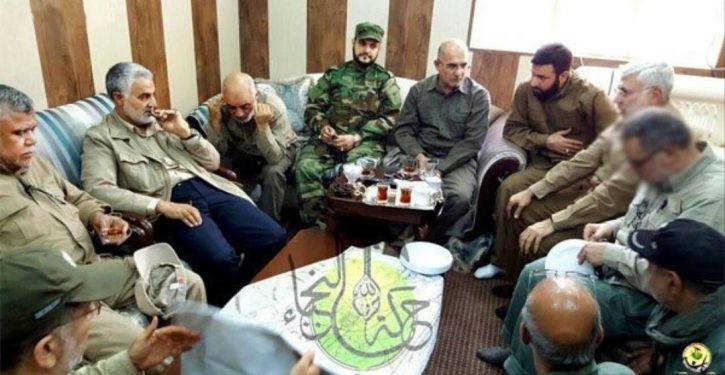
There are a lot of moving parts with the recent back-and-forth dynamic in developments between the U.S., regional nations, and Iran. Without essaying a comprehensive treatment, it is at least illuminating to look at when some of these events occurred and consider them in sequence.
The most recent developments, on Wednesday 15 May, were the announcement of a major personnel drawdown at the U.S. embassy in Baghdad – along with a stringent travel warning to Americans about Iraq – and the U.S. decision to curtail all remaining commercial flights between the U.S. and Venezuela. As we’ll see, the latter is probably related to the ongoing tension with Iran.
The natural starting point for the most pertinent events in the timeline would be the reported defection of a senior IRGC general officer, Brigadier General Ali Nasiri, in April. According to the Islamic State of Iran Crime Research Center (ISICRC), in a 22 April report, Nasiri sought refuge at a U.S. embassy in the Persian Gulf as early as 12 or 13 April, following an 11 April blow-up with Ayatollah Khamenei’s representative in the IRGC.
Will this presidential election be the most important in American history?
Nasiri commanded the IRGC’s Protection Bureau, which provides security for the regime. Prior to receiving that command in 2017, he commanded the Seyyed al-Shohada Guards unit in Tehran Province, the command that handles security in Tehran. This is a high-level defector, in other words. It isn’t clear what kind of information he may be able to provide, but ISICRC says this of him:
Nasiri is said to have gone to a US embassy in one of the Persian Gulf countries while carrying important strategic documents, seeking political asylum. The I[R]GC’s Protection Bureau was established in 1984, to oversee aviation and flight security (hijacking and bombing), as well as protection for regime and government officials, and foreign dignitaries visiting Iran.
The nature of the “strategic documents” may be key; meanwhile, Nasiri’s connection to aviation and flight security is noteworthy in light of a development just prior to his defection.
On 8 April 2019, as reported at the Jerusalem Center for Public Affairs, Iran’s Mahan Air initiated direct flights between Tehran and Caracas. Mahan Air is under U.S. sanctions for its continuing involvement in moving arms and paramilitary troops to Syria, among other flashpoints in the Middle East.
In an interview with Gesell Tobias of VOA published on 14 April, Secretary of State Mike Pompeo expressed grave concern about the new air link.
There’s no doubt Iranian money remains in South America being used for malign purposes, supporting Hezbollah, supporting transnational criminal organizations, supporting efforts at terrorism throughout the region. The United States is working with our partners in this area to take down those networks, to take down that risk. IRGC — you saw the other day there was an air flight straight, straight from Tehran to Caracas. This is Iran intervening in South America. That’s not in the best interest of the South American people, and the United States stands ready. We see Iran for what it is, the world’s largest state sponsor of terror. That’s a global threat, and we’re prepared to push back against it not only in the Middle East but in South America and wherever we find that threat present.
JCPA author Michael Segall provides additional detail on Iran’s presence in Venezuela and other Latin American nations; Emanuele Ottolenghi and John Hannah had an excellent report on the topic at the Jewish Policy Center a few months ago as well. A key take-away from this reporting is that Venezuela, in the midst of meltdown, is a significant source of vulnerability for the U.S. to border infiltration and asymmetric attacks – of the kind senior Iranian officials have been issuing oblique warnings about for months.
Again, it’s not clear exactly what kind of “strategic documents” General Nasiri would have had access to. As the chief of security for top regime officials, however, the access of his security force could have been extensive, even if the job of the force, and Nasiri, did not involve the actual planning of regime strategy and operations. He could have made off with some very enlightening material.
I tend to agree with Michael Ledeen that we don’t want to overstate Nasiri’s impact without knowing more. But the timing of events remains interesting.
On 1 May, the U.S. ended longstanding waivers for customers of Iran’s oil exports, a not-insignificant development in this timeline.
And as previously reported, following the Nasiri defection, the Iranian tanker Happiness I suffered a complete loss of propulsion and steering in the Red Sea on 30 April 2019. That was an odd incident in itself, but later, on 2 May, a post appeared on the social media site Telegram alleging that the tanker had been “hit,” possibly by a rocket or missile, when the ship was rendered dead in the water. The ship was given assistance by Saudi Arabia and towed to Jeddah.
It was the next day, 3 May, that U.S. intelligence reportedly picked up information on Iran “mobilizing proxy groups in Iraq and Syria to attack American forces.” (See here for background on Iran-backed militias in Iraq — and here for recent threats.)
The new intelligence reports surfaced on the afternoon of May 3, [Acting Defense Secretary Patrick] Shanahan told Congress last week.
(The longstanding connection of the IRGC’s Qassem Soleimani with the Iraqi militias is well-known.)
https://twitter.com/HeshmatAlavi/status/1117412679147298816
Does the U.S. have leverage to have Ameri and Mohandes removed from GOI & Hashd leadership?
The resolve to designate and target IRGC-QF proxies?
Soleimani is operating in an evironment where "No" is the answer to both
Until he's worried about a "Yes" option – Iran wins Iraq. pic.twitter.com/JXzGaJkeL8
— Michael P Pregent (@MPPregent) May 15, 2019
The decision to move the recently deployed carrier USS Abraham Lincoln (CVN-72) into CENTCOM was announced shortly afterward.
On May 5, Mr. Bolton announced the first of new deployments to the Persian Gulf, including bombers and an aircraft carrier.
Two days later, on 7 May, a CENTCOM spokesman referred to that 3 May intelligence in a media briefing. According to CNN, other Pentagon sources also told CNN reporters about an Iranian plan to move ballistic missiles by sea, possibly for the purpose of using them from a seaborne platform. (See my link above for more on that.) This separate reporting appeared to relate to the specific threat posed by proxy forces, detected on the afternoon of 3 May.
On 8 May, the Trump administration announced the latest round of sanctions on Iran, which will impose the deepest bite yet on Iran’s money-making mineral and metals sector, a key source of cash for Iranian weapons and foreign-interference programs.
It was following these events that four oil tankers near the UAE port of Fujairah, on the Gulf of Oman, suffered casualties on 12 May 2019. The nature of the damage wasn’t initially clear, but later reporting and video evidence indicated that each ship had a relatively small hole in its hull, down by the waterline, which looked (my judgment) as if it may have been punched by a shaped explosive delivered by something traveling on or just below the surface. My guess would be a waterborne drone being used to deploy a command-detonated device.

The U.S. assessed afterward that Iran was likely behind this attack. On Tuesday 14 May, the Saudis reported attacks by armed drones launched from Yemen on the East-West oil pipeline that runs between Yanbu on the Red Sea and Ras Tanura on the Persian Gulf. The U.S. also believes Iran was behind those attacks, which would have been mounted by Iran-backed Houthis in northern Yemen.
The decision on 15 May to issue the travel warning for Americans in Iraq, and draw down the personnel presence at the U.S. embassy in Baghdad and the consulate in Erbil, is reportedly due to the threat of proxy attacks backed by Iran, for which the initial specific intelligence was picked up back on 3 May.
The Trump administration ordered a partial withdrawal of its diplomats from Iraq on Wednesday, as Washington warned of heightened threats from Iran and Tehran-backed Shiite militias.
The Washington Times cites reporting from administration sources that the Iran-backed militias in Iraq have moved rockets within range of bases from which U.S. troops operate. Since the militias have transportable rockets that could be used against U.S. forces at any time with little or no prior warning, the exact meaning of this reporting isn’t clear; i.e., how the new situation differs from what has been the case for months. It may be that more powerful, longer range missiles have been detected moving into sectors of Iraq. The TWT report also cites Reuters saying that the militias have moved into more threatening positions near U.S. forces.
In any case, Mike Pompeo briefed Iraqi authorities on this concern during an unscheduled stop in Baghdad on 7 May, and shared what appears to be the same thread of intelligence with Britain, France, Germany, and the EU foreign ministry on 13 May, on the way to Russia.
Meanwhile, on the 15th, the U.S. also suspended all flights between the U.S. and Venezuela. Passenger flights had been halted in March, but there will be no further cargo flights either for the time being. Although it’s possible that this is related solely to developments in Venezuela, it’s more likely, given the timing, that the impetus for this move comes at least partly from intelligence about Iran-backed threats.
Additional implications
Three additional comments. One, there was another, related development in the midst of this timeline: the extraordinary series of rocket attacks on Israel – some 600 in total – launched from Gaza on 4 and 5 May. This widespread attack, mounted by Palestinian Islamic Jihad and Hamas, was no doubt backed and instigated by Iran, and was quite probably an attempt to generate wider regional chaos in the week U.S. sanctions were being tightened.
The attacks on Israel are a reminder that Iran will try to expand the operational problem beyond the proximate precincts of the oil-trade-involved nations around the Gulf, and in particular the Strait of Hormuz.
The attacks on Israel invite a similar reminder that Iran may well attempt to retaliate elsewhere (as alluded to by Qassem Soleimani in 2018 in his noted “adult diapers” address), including asymmetric attacks directly on the United States. Venezuela being in play as an operational waypoint for such attacks is an obvious concern. (I would likewise not forget the potential for Nicaragua to be a waypoint, especially since it is located north of the Darien Gap.)
Two, the media are making much at the moment of the skepticism of our European allies about the threat intelligence Mike Pompeo briefed them on (see links above). In that regard, it’s worth noting that some of them have nevertheless suspended cooperative training with Iraqi forces, suggesting that there’s something they’re taking seriously.
The Spanish frigate Mendez Nunez has also been pulled from her deployment with the Abraham Lincoln strike group (which reportedly is in the Gulf of Oman, outside the Strait of Hormuz, as of 15 May).
Here’s the key thing to keep in mind when listening to the European allies. Their strategic objective is different from ours. They’re on the same side as Iran: they want to keep the JCPOA (nuclear “agreement”) in place, rather than negotiating a more effective one that would actually prevent Iran from acquiring nuclear weapons.
The Europeans want to continue doing business with Iran, instead of being deterred by U.S. sanctions. Iran wants to keep doing business with them. So when the Europeans say they don’t perceive the same threat the U.S. does, that doesn’t mean the intelligence isn’t there, or isn’t valid. It means, literally, that they don’t perceive it as a threat to themselves.
So don’t be deceived by what is said in that regard, by the Europeans or the mainstream media. None of it is an indictment of the intelligence itself – which may or may not be valid, but isn’t proven invalid by the commentary of those by whom it is not perceived as a threat.
Three, the problem at the root of all of this – the Iranian nuclear weapons program – may have received a boost of illumination from the Iranian defector, General Nasiri. As LU contributor Jeff Dunetz points out, citing Kenneth Timmerman, Nasiri would have specific knowledge of the status at some of the nuclear-related facilities in Iran. This it not because Nasiri was the intelligence chief of the IRGC, as Timmerman puts it (that doesn’t seem to be the case), but rather because of his command charter to provide security for regime officials.
More on this final point in a separate post. It always comes back to the nuclear weapons program, and the search for ways to prevent the radical regime from realizing its ambitions.




